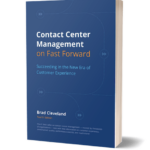Organizations are made up of people with myriad personalities, backgrounds and skills. Success depends on creating an engaging environment and bringing out the best in everyone who is part of it. But, as many leaders have learned (some the hard way), off-the-shelf prescriptions and simplistic formulas tend to fail.
Fortunately, there are leadership principles that build employee engagement. Here’s a summary of principles I’ve observed:
We respond to a clear, compelling mission.
A needed first step to creating a motivating environment is to address the “whats” and “whys.” Why do the organization and the contact center exist? What are we trying to achieve? What’s in it for customers? For employees? Shareholders? Other stakeholders?
It’s what you do, not what you say, that matters.
There are  countless organizations that codify their “official” values, but then encourage an entirely different set of behaviors through their policies and actions. For example, delivering great customer experiences may be the stated objective, but insufficient staffing resources or standards that stress volume-oriented production may send conflicting messages. When it comes to influence, actions always win out over words.
countless organizations that codify their “official” values, but then encourage an entirely different set of behaviors through their policies and actions. For example, delivering great customer experiences may be the stated objective, but insufficient staffing resources or standards that stress volume-oriented production may send conflicting messages. When it comes to influence, actions always win out over words.
Effective communication cultivates trust.
Communication creates meaning and direction. When good communication is lacking, the symptoms are predictable: conflicting objectives, unclear values, misunderstandings, lack of coordination, confusion, low morale, and employees doing the bare minimum required to get by. To build and maintain engagement, effective leaders keep their teams informed about what’s happening in the organization.
Good training and coaching is essential.
There’s nothing more stressful and frustrating than not knowing what to do in real, live customer service situations (if you’ve been there, you know what I mean!). Knowing how to approach any situation makes all the difference. Confidence is built by providing robust training and coaching (including role-playing tough scenarios). When I asked an employee about her company’s improved training and coaching, she said, “I went from dreading my day to looking forward to it; I love being a problem solver!”
Listening encourages buy-in and support.
There is a common myth that great leaders create compelling visions out of their own genius or from some inner creativity that others don’t possess. But those who have studied leadership point out that the visions of some of history’s greatest leaders often came from others. Further, when people have a stake in an idea, they tend to work much harder to bring about its success.
We tend to live up to expectations.
Think of your own development over the years. Those coaches, teachers or business mentors who believed in you and expected the most probably weren’t the easiest on you. And they may not have won popularity contests. But they believed in you, and you reached a little deeper to live up to their expectations.
Sincere recognition goes a long way.
In study after study, participants say that personalized and sincere recognition from their managers—simply being recognized for doing a good job— is a powerful motivator. (Easier said than done, of course. You have to really know what’s going on from top to bottom to get it right … but isn’t that a part of leadership, anyway?)
Accurate resource planning is essential.
Yep, in customer service, this matters a lot. We’ve got to have “the right people in the right place at the right times, doing the right things.” When that doesn’t happen, negative things do: queues build, customers become unhappy, and occupancy goes through the roof. It’s stressful. And, if chronic, it zaps motivation and drains the fun out of the environment.
Who you are is more important than any technique you use.
We trust and perform for leaders who are predictable on matters of principle, and who make their positions known. Unwavering convictions, a sense of fairness, consistency of behavior and enacted values, belief in the capabilities of people—these things have much more impact than any motivational technique ever could.
One thing is certain: leaders in organizations that maintain the highest levels of engagement don’t leave it to chance. They know that employees who are interested in and enthusiastic about their work create great results for customers and the organization.
Excerpt from Contact Center Management on Fast Forward by Brad Cleveland.
